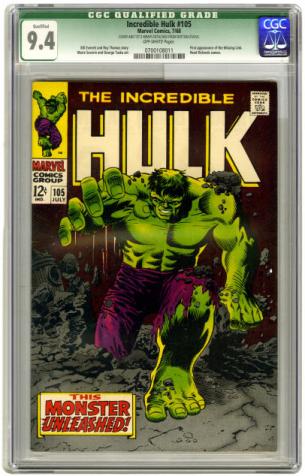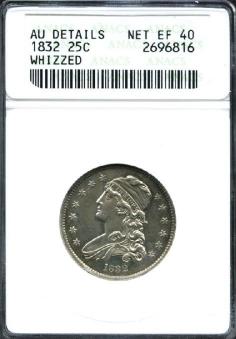|
NostoNews, June 1, 2006
by Tommy Jasmin But what's the grade? Grading collectibles has come a long way in recent years. As is always the case, if there is an economic driver for something, it will happen. If a grade difference of one or two points can mean a difference in value of thousands of dollars (or for some coins, hundreds of thousands of dollars) the market for professional, impartial grading services exists. The professional coin grading services have been around the longest, and as a result all the relevant issues in providing such a service have been pretty much worked out. Technological advances have provided the means to create high quality protective holders, to detect restoration with a high degree of accuracy, and to store and track information in databases about the individual graded items. One of the considerations in professional grading most important to a service like Nostomania is determination of the true grade for an item. Yes, this should sound very strange - isn't that the whole point? You'd think so. How does one qualify for Qualified? For some inexplicable reason, someone near the top decided comic books with significant defects that would otherwise be high grade should still be given this "if not for" grade, and simply tagged Qualified. Check out the example below. This book has the cover and the first three wraps detached at the bottom staple, yet we see a professional assigned grade of Qualified NM 9.4. Excuse me? Yes, it's an unfortunate defect, but I'm sorry - this book is not NM. 
To illustrate further just how ludicrous Qualified grades are, what's keeping me from saying every book in my collection is a "Qualified MT 10.0?" After all, hell, if this book here didn't have this 1 inch tear and this corner crease and this spine scuff, it would be Mint! Why do some books "qualify" for qualified and not others? The answer is none of them should. Every book should be treated the same, and graded by the same rules. Apparently useless The same holds true for Apparent grades, which are assigned when restoration is detected in a book. For example, if an otherwise NM book has been trimmed, it will be assigned a grade of Apparent NM 9.4, with the trimming noted on the holder. Again, to me the real answer here seems simple: note the defect but assign a true grade. In this case, the book is technically incomplete, but the severity is less than a missing page, as no real content is absent. So this book should grade in the FR/GD range. The free collection management service Nostomania provides its users is dependent on one thing: knowing the grade. If you can determine the grades for your coins or comics, and in the future who knows what else, we can determine values. You enter what you have, and we tell you how it changes in value over time, cool. But if you don't know the true grade, you're stuck. At present, we can't help you if you own a book with a Qualified grade. With no idea of the true grade, we have no idea of the true value. Do you want to enter your Qualified NM 9.4 Amazing Spider-Man 1 into our system as a NM 9.4? Go ahead, but good luck trying to get the $57,600.00 we compute a true 9.4 to be worth. To be fair, there is one very useful aspect of the Apparent grade: it tells you restoration of some sort is present. This in itself is an extremely valuable service, and often alone worth the price of admission. The average Joe may be able to determine a reasonably accurate grade, but detecting restoration can be very difficult. Makes no sense at all I don't know why the comic graders are afraid to assign a book its rightful grade just because it is pretty or is a key. I saw on Your Comics Online a justification for the Qualified grade (pulled verbatim with typo): A Qualified label is used by CGC for certified books that have a significant defect that needs specific description. For example, it is would be a disservice to the seller and buyer to call a VF/NM book with a 4-inch back cover tear a VG, so CGC will give this book a Qualified grade of "VF/NM 9.0, back cover 4-inch tear." No guys, it's a serious disservice to the seller or buyer to not give a determination of the actual grade. You're breaking your own very credible and accepted rules for grading. The grade of a collectible is based on the total accumulation of defects. That's it. No exceptions. Of course some defects will weigh in on the grade determination differently from book to book (tape on a book that is already FR does not make the book less than FR), but you don't just gloss over defects for some books and not others. The coin graders got it right It's comforting at least to know the coin graders found a simple solution when restoration or unfortunate defects are present on an otherwise nice specimen. Sometimes, they will simply refuse to assign the coin a grade. But often, they note the general grade range the item may appear to a non-professional, and assign a "net" grade that takes into account all defects. This is typically noted (Apparent Grade) details, net (Actual Grade). See the example below, which shows an 1832 Liberty Cap Quarter graded "AU Details, Net XF-40". The lower grade is due to whizzing, a form of restoration that is essentially polishing. 
If you agree with me on the importance of assigning a true grade, let the professional comic book graders know - heard voices are the only thing that will lead to change. If you're content sending your books in to be graded and not learning the real grade, why waste your money? Save some dough and give them all a Qualified MT 10.0. Prizes Don't forget, all you have to do is create a single Collection, Wantlist, or Salelist item during the appropriate month to qualify for our sweepstakes. Why not take a look and see what we're giving away (and gave away last month), free as always. Thanks, we'll see you all next month. Visit our NostoNews Archive. |